Neat places just to walk around
Paris is a walker's dream, both because it has great natural urban beauty and also because at various points in the city's history tremendous resources were expended to make it even more walkable. When the Pont Neuf was opened at the beginning of the seventeenth century, unlike the bridges that preceded it, houses were not constructed along its sides, which invited people to look out over the river and take in the beauty of the city (as well as the beauty of the other city-gazers, it turned out). In the nineteenth century new boulevards were constructed to provide people not only places to walk, but also things to see—and, as before, the opportunity to be seen as well. In the nineteenth century a new figure entered the cityscape: the "flâneur," which is sort of like a wanderer, someone who walks around with no particular purpose. Now you can be a modern-day flâneur.
Not all the places on the map below are described in detail on this page, but all of them offer up great people watching, natural or manufactured beauty, and just good stuff to look at. Grab a bus or the metro and zip off to one or all of these locations. Tom promises you'll have a great walk.
If you're a walker, you'll also want to check out Tom's suggestion for Strange and Interesting Walks for some detailed, step-by-step treks.
The Marais. The marais (marshland) is almost as old as the oldest inhabited parts of Paris, having first been settled in the 13th century. It's especially noted for its old hotels particuliers, private mansions built by wealthy aristocrats (many are used as museums or other official buildings today). Beginning about 1880, this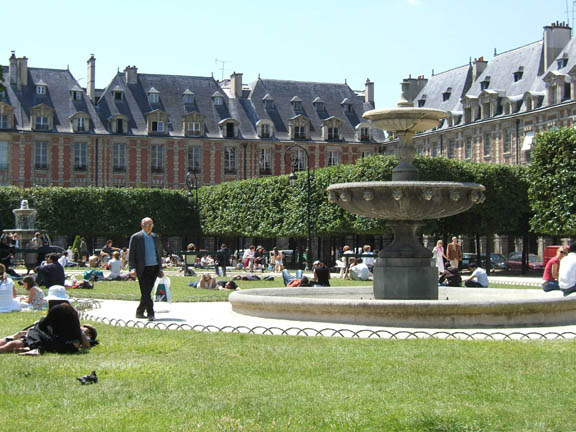 area was settled by Jewish immigrants, and it retains a great deal of that character today. It is also Paris' premier gay neighborhood, and home to trendy restaurants and night spots. You should note that if the weather's nice, it's especially appealing to walk around the marais on a Sunday afternoon, because lots of people head over there, and most of the shops are open, which isn't generally the case in a lot of other parts of the city. Take the metro to Saint Paul. Get off. Head east (toward the Bastille) on the rue Saint Antoine about 200-300 yards, and turn left on a little street named the Rue de Birague and into the Place des Voges (pictured here). This is real neat. Walk around and wish you could own an apartment here. One of the most expensive apartments ever sold in Paris is located on the two floors spanning the central arches in the photo at above. (Want to know what the most expensive residential real estate transaction in Paris has been? Check out the seventeenth-century mansion, the Hotel Lambert, which not too long ago sold for over 200,000,000 euros.) Then wander around, in general slightly west. I recommend exiting the Place des Vosges at the northern end, and heading west on the rue des Francs Bourgeois. Take a left on the rue Vieille du Temple, then another left on the rue des Rosiers (and get some falafel at the As du Falafel, pictured here; it ain't for nothin' there's a line there at 34, rue des Rosiers), then right on the rue Malher. Another right on the rue du Roi de Sicile, and keep heading down that street for quite a while—it'll
area was settled by Jewish immigrants, and it retains a great deal of that character today. It is also Paris' premier gay neighborhood, and home to trendy restaurants and night spots. You should note that if the weather's nice, it's especially appealing to walk around the marais on a Sunday afternoon, because lots of people head over there, and most of the shops are open, which isn't generally the case in a lot of other parts of the city. Take the metro to Saint Paul. Get off. Head east (toward the Bastille) on the rue Saint Antoine about 200-300 yards, and turn left on a little street named the Rue de Birague and into the Place des Voges (pictured here). This is real neat. Walk around and wish you could own an apartment here. One of the most expensive apartments ever sold in Paris is located on the two floors spanning the central arches in the photo at above. (Want to know what the most expensive residential real estate transaction in Paris has been? Check out the seventeenth-century mansion, the Hotel Lambert, which not too long ago sold for over 200,000,000 euros.) Then wander around, in general slightly west. I recommend exiting the Place des Vosges at the northern end, and heading west on the rue des Francs Bourgeois. Take a left on the rue Vieille du Temple, then another left on the rue des Rosiers (and get some falafel at the As du Falafel, pictured here; it ain't for nothin' there's a line there at 34, rue des Rosiers), then right on the rue Malher. Another right on the rue du Roi de Sicile, and keep heading down that street for quite a while—it'll 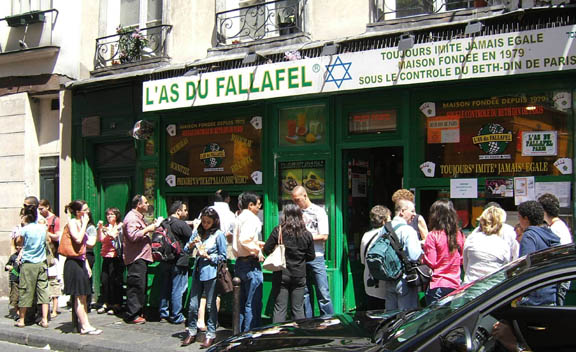 turn into the rue de la Verrerie. There's a lot of interesting stuff to look at around here. Walk around as many of the little tiny streets in the marais as you can and just look at the neat old buildings and quirky and chic shops. Other good streets to check out are the Rue des Blancs Manteaux (Street of the White Coats), the Rue du Plâtre, and the Rue des Mauvais Garçons (Street of the Bad Boys). Also cruise the rue Vieille du Temple. The restaurant pages in Tom's Guide name some interesting places in the marais to eat, and if you just walk around that area you'll find plenty of places to chow down, to have a meal, or to dine in high style. If you feel bold as you're strolling through the neighborhoods, go into one of the myriad
turn into the rue de la Verrerie. There's a lot of interesting stuff to look at around here. Walk around as many of the little tiny streets in the marais as you can and just look at the neat old buildings and quirky and chic shops. Other good streets to check out are the Rue des Blancs Manteaux (Street of the White Coats), the Rue du Plâtre, and the Rue des Mauvais Garçons (Street of the Bad Boys). Also cruise the rue Vieille du Temple. The restaurant pages in Tom's Guide name some interesting places in the marais to eat, and if you just walk around that area you'll find plenty of places to chow down, to have a meal, or to dine in high style. If you feel bold as you're strolling through the neighborhoods, go into one of the myriad 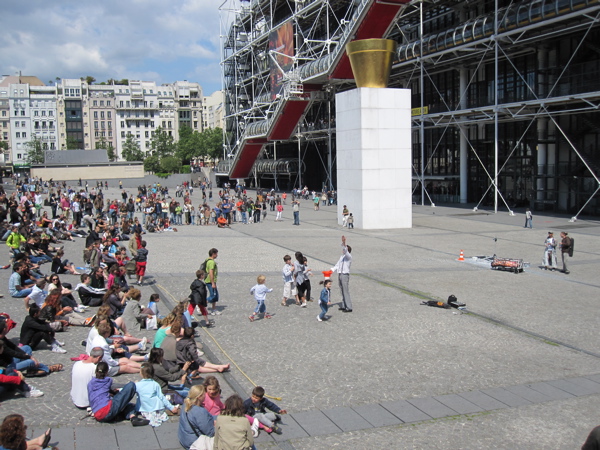 courtyards and marvel at the old buildings. The marais has all kinds of interesting (and, alas! expensive) shops that will have things you won't find elsewhere, including art, clothing, and jewelry.
courtyards and marvel at the old buildings. The marais has all kinds of interesting (and, alas! expensive) shops that will have things you won't find elsewhere, including art, clothing, and jewelry.
In the same general area—actually, if you're walking around in the marais you might end up here accidentally anyway, since it's just about immediately to the east—is the area around Les Halles and the Pompidou Center. This is especially interesting on a nice Sunday afternoon, since all sorts of street performers will gather and do weird and sometimes surprizingly good acts.
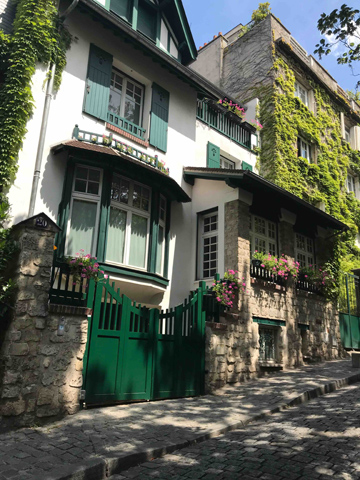 You willl certainly go to Montmartre. This hill situated at the northern edge of Paris has been occupied since Gallo-Roman times, and the first church was erected here in the sixth century. Legend has it that the martyr Saint Denis, who was decapitated and then miraculously ran off, carrying his own head, passed through Montmartre and descended the north slope of the hill before landing on the site of what is know the site of the basilica Saint Denis, which you should certainly visit. Some versions of the Saint Denis story
You willl certainly go to Montmartre. This hill situated at the northern edge of Paris has been occupied since Gallo-Roman times, and the first church was erected here in the sixth century. Legend has it that the martyr Saint Denis, who was decapitated and then miraculously ran off, carrying his own head, passed through Montmartre and descended the north slope of the hill before landing on the site of what is know the site of the basilica Saint Denis, which you should certainly visit. Some versions of the Saint Denis story 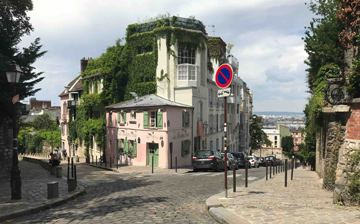 mystifyingly claim that he kissed his own head after picking it up—you do the math. (The image of St Denis here is one that I had ChatGPT generate. I guess you can kiss your own head when you have two of them.) Montmartre wasn't an official part of Paris until 1859, and it's always been just a little bit independently separate.
mystifyingly claim that he kissed his own head after picking it up—you do the math. (The image of St Denis here is one that I had ChatGPT generate. I guess you can kiss your own head when you have two of them.) Montmartre wasn't an official part of Paris until 1859, and it's always been just a little bit independently separate.
 You can spend a lot of time walking around this little village in Paris, and most people unfortunately just take the cable car ("funiculaire") up the slope—or you could go up the 222 steps instead—gawk at the view from the front of Sacré Cœur, and then go over to the tourist-ridden Place du Tertre. You do need to see this, but some might want to take the cutesy stuff in small doses.
You can spend a lot of time walking around this little village in Paris, and most people unfortunately just take the cable car ("funiculaire") up the slope—or you could go up the 222 steps instead—gawk at the view from the front of Sacré Cœur, and then go over to the tourist-ridden Place du Tertre. You do need to see this, but some might want to take the cutesy stuff in small doses. 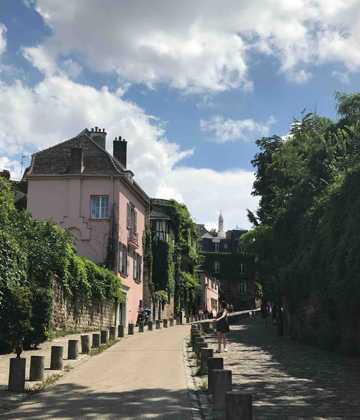 The Place du Tertre is on the site of a 12th-century monestary; and it was the site of artistic, theatrical, and other sorts of bohemian activity for a couple hundred years: Picasso, Utrillo, and other world-class artists had their studios in this general area. The Place du Tertre is all well and good, but there's so much more on this, Paris' most famous butte (butte means "hill"). Tom really tries to avoid sounding like a Paris snob, but if you get off that main drag and walk around, you'll find an inexplicably charming part of town with nice shops and good, inexpensive restaurants. The trick with walking around Montmartre is to start low and aim high. What I mean by that is you should begin your exploration at the bottom of the hill, preferably at either metro Pigalle or Abesses, and walk around however you like, but make sure always to be heading slightly up hill and make sure to bear toward the west. (OK, you can take a road that looks really charming that might not be leading exactly straight up, but you get the general idea: over the course of your Montmartre journey, you should be moving gradually upward.) You're still going to
end at the Place du Tertre, but you'll discover all sorts of great things on the way, including, for example, the Bateau-Lavoir, at the Place Emile-Goudeau,
the location of Picasso's and
The Place du Tertre is on the site of a 12th-century monestary; and it was the site of artistic, theatrical, and other sorts of bohemian activity for a couple hundred years: Picasso, Utrillo, and other world-class artists had their studios in this general area. The Place du Tertre is all well and good, but there's so much more on this, Paris' most famous butte (butte means "hill"). Tom really tries to avoid sounding like a Paris snob, but if you get off that main drag and walk around, you'll find an inexplicably charming part of town with nice shops and good, inexpensive restaurants. The trick with walking around Montmartre is to start low and aim high. What I mean by that is you should begin your exploration at the bottom of the hill, preferably at either metro Pigalle or Abesses, and walk around however you like, but make sure always to be heading slightly up hill and make sure to bear toward the west. (OK, you can take a road that looks really charming that might not be leading exactly straight up, but you get the general idea: over the course of your Montmartre journey, you should be moving gradually upward.) You're still going to
end at the Place du Tertre, but you'll discover all sorts of great things on the way, including, for example, the Bateau-Lavoir, at the Place Emile-Goudeau,
the location of Picasso's and
 other artists' studios. And here's another tip: as you progress upward, keep turning around and looking behind you. That's not because you're in danger of being attacked; it's because some of the best views of the city might well be behind you,and it would be a shame to miss them. You might even see, for example (as you do here), Paris' lone remaining vineyard, which still produces several hundred bottles of wine per year. You can do Montmartre any time of the day, but Tom suggests late afternoon to around sunset for maximum effect. "Strange and Interesting Walk #1" gives you some detailed, step-by-step instructions for exploring parts of Montmartre.
other artists' studios. And here's another tip: as you progress upward, keep turning around and looking behind you. That's not because you're in danger of being attacked; it's because some of the best views of the city might well be behind you,and it would be a shame to miss them. You might even see, for example (as you do here), Paris' lone remaining vineyard, which still produces several hundred bottles of wine per year. You can do Montmartre any time of the day, but Tom suggests late afternoon to around sunset for maximum effect. "Strange and Interesting Walk #1" gives you some detailed, step-by-step instructions for exploring parts of Montmartre.
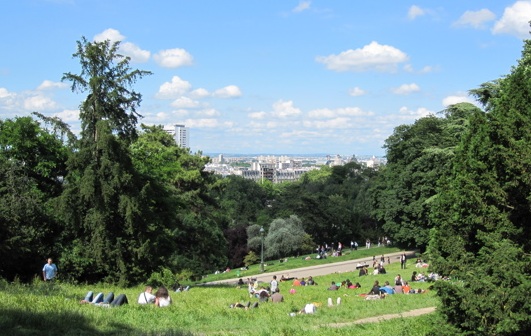 Now if you've been paying attention, you know what theword butte means, and so you won't be surprised at the geography in the Parc des Buttes-Chaumont (metro of the same name). A lovely park, way up high, with nice trails. It's extremely calm and peaceful here. Some folks are miffed at me for spoiling this secret, so don't tell anyone about it. Just pack a lunch, bring a blanket, and have a relaxing picnic.
Now if you've been paying attention, you know what theword butte means, and so you won't be surprised at the geography in the Parc des Buttes-Chaumont (metro of the same name). A lovely park, way up high, with nice trails. It's extremely calm and peaceful here. Some folks are miffed at me for spoiling this secret, so don't tell anyone about it. Just pack a lunch, bring a blanket, and have a relaxing picnic.
Ile St-Louis. This is the little island in the Seine. Metro Pont-Marie or Sully Morland. My favorite way to get here, though, is by walking along the little street that runs to the left side of Notre Dame (as you're facing the cathedral). This is the rue du Cloître Notre-Dame, and there are some tourist shops that can be interesting, actually, along there, as well as a completely fantastic museum dedicated to Notre Dame (which is very, very interesting, but only if you're as 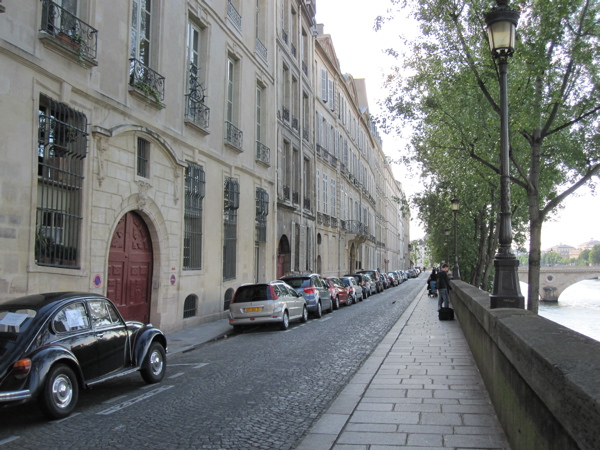 obsessed with the place as I am). When you get to the end of the street, take a left across the pont St. Louis and onto the island. That bridge, by the way, is closed to traffic and it very often has strange and sometimes wonderful entertainment there during the summer. Someone might bring a centuries-old band machine and play it, a concert violinist might show up, you'll get those people who pretend to be statues (this just escapes me completely) or, my favorite, the kids on rollerblades doing absolutely amazing jumps and other death-defying feats. Go to the Berthillon
obsessed with the place as I am). When you get to the end of the street, take a left across the pont St. Louis and onto the island. That bridge, by the way, is closed to traffic and it very often has strange and sometimes wonderful entertainment there during the summer. Someone might bring a centuries-old band machine and play it, a concert violinist might show up, you'll get those people who pretend to be statues (this just escapes me completely) or, my favorite, the kids on rollerblades doing absolutely amazing jumps and other death-defying feats. Go to the Berthillon
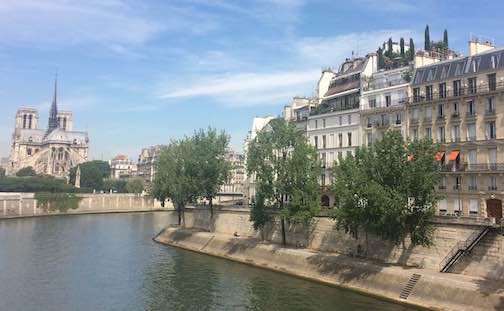 ice cream shop at the north end of the island. It's beyond good. Then, stroll down the street that bisects the island length-wise (rue St Louis en l'île) and look at all the cool shops and restaurants. You'll find some really nice stuff here. You should also walk the entire perimeter of the island, looking at the fabulous buildings. Check out the plaques that identify previous residents of these buildings (you'll be impressed if you know anything at all about French history and culture). If you're here on a Sunday afternoon, this is a good place to start before you walk on over to the marais (see above). The best way to get there from the Ile St Louis is to cross the Pont de Sully
ice cream shop at the north end of the island. It's beyond good. Then, stroll down the street that bisects the island length-wise (rue St Louis en l'île) and look at all the cool shops and restaurants. You'll find some really nice stuff here. You should also walk the entire perimeter of the island, looking at the fabulous buildings. Check out the plaques that identify previous residents of these buildings (you'll be impressed if you know anything at all about French history and culture). If you're here on a Sunday afternoon, this is a good place to start before you walk on over to the marais (see above). The best way to get there from the Ile St Louis is to cross the Pont de Sully
 at the far east end of the island, go up the sprawling Avenue Henri IV to the Bastille, and then turn left onto the rue St. Antoine. Turn right onto the rue de Birague and go into the Place des Vosges. See above for further info. While on the Ile St Louis, make sure also to check out the "point," especially on a nice summer day (you'll see what I mean if you head over to the far western end of the island, but in case you can't figure it out, that's it at left). Bring something to eat and drink... If you're as fascinated by the Ile Saint-Louis as I am, consider taking a walking tour for only 10 euros through Paris Balades. I especially recommend the one conducted by Pierre-Yves Jaslet (but you have to be able to speak French to follow this fascinating and knowledgeable man). Check out M. Jaslet's website for a detailed schedule of his tours, lunches, and dinners. M. Jaslet turned me on to a novel about people who live on the Ile Saint-Louis and who consider seceding from Paris. It's called Le Sérénissime, and it's by Frédéric Vitoux. I don't know if it's been translated into English.
at the far east end of the island, go up the sprawling Avenue Henri IV to the Bastille, and then turn left onto the rue St. Antoine. Turn right onto the rue de Birague and go into the Place des Vosges. See above for further info. While on the Ile St Louis, make sure also to check out the "point," especially on a nice summer day (you'll see what I mean if you head over to the far western end of the island, but in case you can't figure it out, that's it at left). Bring something to eat and drink... If you're as fascinated by the Ile Saint-Louis as I am, consider taking a walking tour for only 10 euros through Paris Balades. I especially recommend the one conducted by Pierre-Yves Jaslet (but you have to be able to speak French to follow this fascinating and knowledgeable man). Check out M. Jaslet's website for a detailed schedule of his tours, lunches, and dinners. M. Jaslet turned me on to a novel about people who live on the Ile Saint-Louis and who consider seceding from Paris. It's called Le Sérénissime, and it's by Frédéric Vitoux. I don't know if it's been translated into English.
You're going to walk around a lot in the Latin Quarter.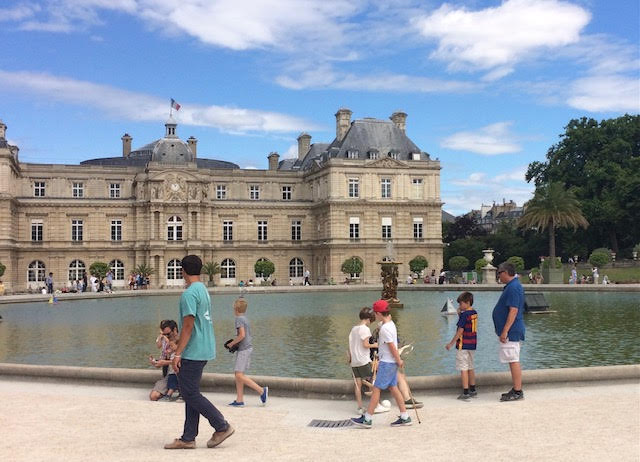
Luxembourg Gardens. A giant park at the topof the Latin Quarter (just walk up the boulevard Saint Michel to the top of the slope), where locals and tourists spend Sunday afternoons (and other times) promenading, sailing toy boats in whimsical fountains, and listening to concerts in octagonal covered bandstands. The flower gardens, surveilled by severe classical sculptures, are pretty but somewhat turgid, and the whole park is lovely, orderly, and calming. There are these great metal chairs that you can drag to wherever you want and sit
on them for as long as you like and read or watch people passing by or listen
 to a concert, but beware: there are two kinds of these chairs, and you must get the kind with the arms. It's not so much a matter of which kind of chair is more comfortable—rather, it's about status. Sitting on one of the armless chairs is very déclassé, and if you're going to be in the Luxembourg Gardens, part of the thing is to be seen. How horrible would it be to be seen in one of the low-class chairs? You might find that you have to maneuver somewhat to get the highly coveted chairs, especially on a nice Sunday afternoon when they're at quite the premium. Sometimes you'll see someone getting up to leave out of theirs, and several people will make a mad dash for the chair, but the thing here is that you have to make your mad dash without appearing to. You have to look somewhat nonchalant as you do this or else you lose even more status. When there's a band concert in the gardens, people over a certain age (i.e., not you) will sit in the chairs, listen to the music, and conduct. It's weird.
to a concert, but beware: there are two kinds of these chairs, and you must get the kind with the arms. It's not so much a matter of which kind of chair is more comfortable—rather, it's about status. Sitting on one of the armless chairs is very déclassé, and if you're going to be in the Luxembourg Gardens, part of the thing is to be seen. How horrible would it be to be seen in one of the low-class chairs? You might find that you have to maneuver somewhat to get the highly coveted chairs, especially on a nice Sunday afternoon when they're at quite the premium. Sometimes you'll see someone getting up to leave out of theirs, and several people will make a mad dash for the chair, but the thing here is that you have to make your mad dash without appearing to. You have to look somewhat nonchalant as you do this or else you lose even more status. When there's a band concert in the gardens, people over a certain age (i.e., not you) will sit in the chairs, listen to the music, and conduct. It's weird.
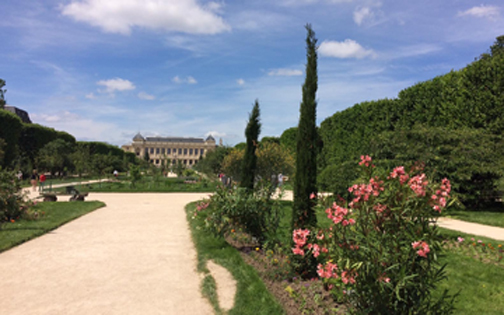 The Jardin des plantes is a remarkable botanical garden which you might think would be boring, but it's a pretty great place to stroll around in. It's absolutely huge, and there are all kinds of signs and little notes explaining what each of the plants, shrubs, and trees are. My favorites are the medicinal plants, and they speculate about some of them, saying that certain ones may aid digestion. They also tell you that in small doses some of these plants are helpful, but they'll kill you in larger doses. Good to know. This place was created in 1635, and it's a real treat to stroll around in. The principal entrances are on the rue Cuvier and the rue Buffon. There's also a zoo (ménagerie) that's worth checking out if you like animals. The enclosures are sort of natural. You can see the wallabies and some of the other animals without going into the zoo (there's an admission charge of 13 euros for the zoo).
The Jardin des plantes is a remarkable botanical garden which you might think would be boring, but it's a pretty great place to stroll around in. It's absolutely huge, and there are all kinds of signs and little notes explaining what each of the plants, shrubs, and trees are. My favorites are the medicinal plants, and they speculate about some of them, saying that certain ones may aid digestion. They also tell you that in small doses some of these plants are helpful, but they'll kill you in larger doses. Good to know. This place was created in 1635, and it's a real treat to stroll around in. The principal entrances are on the rue Cuvier and the rue Buffon. There's also a zoo (ménagerie) that's worth checking out if you like animals. The enclosures are sort of natural. You can see the wallabies and some of the other animals without going into the zoo (there's an admission charge of 13 euros for the zoo).
Sam of Paris warns folks of the following:It seems that every Parisian has a dog, most of them of the small, nasty variety, though I have also seen Great Danes galloping down the streets followed by their jockeys. Even though the French have been warned for years to use poop-scoops, and there are even penalties for not using them, many of them come out at night with their precious quadrupeds and let them indulge in what comes naturally. Streets in Paris used to be cleaned of such unsightly and dangerous stuff daily by mostly young people sitting on terrifying green machines equipped with a long, vacuuming arm that was placed over the offending mound. In recent years, due to economic restrictions, such niceties have been reduced to a minimum. So when you walk down the streets of Paris, particularly the narrow ones, make sure to scan the sidewalk about twenty feet in front of you before you proceed so as to avoid stepping on something unpleasant. Even if you think you've mastered the art of dodging you'll be mistaken, for it's often an obstacle course. Be particularly careful when you walk between parked cars, for that's where most proud owners of dogs lead their charges when no one is looking. |
At the risk of ruining a perfectly nice, quiet little neighborhood by causing it to be overrun with the throngs of folks who read Tom's Guide, I'm going to turn you on to a corner of the city you probably otherwise wouldn't choose to visit: La Butte aux Cailles. This is one of Paris' seven hills (can you find the others?), and it's situated in a part of town that 20 years ago many (alright—me) would have considered out in the sticks. This area just southwest of the Place d'Italie is a totally charming blend of quiet village and 1990 Seattle, only populated by people in their early thirties with slightly more refined taste. It is named after Pierre Caille, who acquired the land on which it is situated back in 1543, and at that time there were fields, vineyards, some woods, and even a few windmills. To get to this neighborhood, get off the metro at Place d'Italie and head down the rue Bobillot; then turn right onto the rue de la Butte aux Cailles. Check out the other streets in the neighborhood, especially the rue des Cinq Diamants and the rue Martin Bernard. There are some really nice, cozy, and sophisticated little restaurants and cafés here, along with the odd little shop selling stuff you never saw before. There's also a live theater, and people who will smile at you on the street as you pass by. It's sort of being in a little village when you're in this neighborhood. UPDATE: The Butte aux Cailles area is so charming, it's soon to be the subject of the next Strange and Interesting Walk.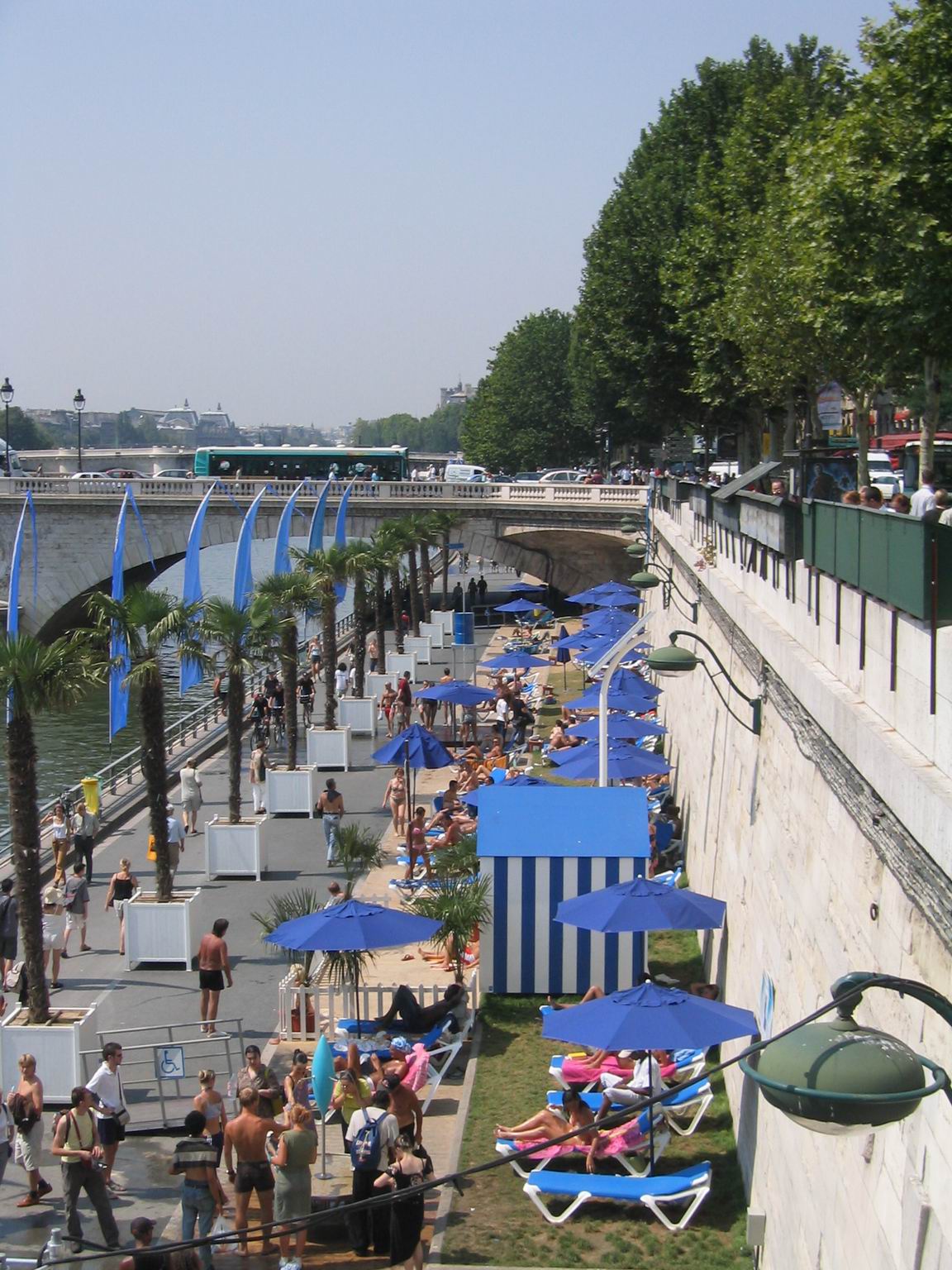
Like going to the beach? There's a beach in Paris—really. Well, sort of, and only sometimes. From mid-July through August they set up the Paris Plage, which is something you really have to see. It's set up along the northern side of the Seine, with its center of activity mainly situated around the stretch along the two islands, but the whole beach goes further than that. This is a really strange thing: the city spends millions on it, trucking in sand, palm trees and other beach-like things. They set up floating stages in the Seine, there are all sorts of concession stands, and you can even borrow books to read while you're sunbathing in your nice comfortable deck chair. They also set up those water misters at strategic points along the river so you can cool off. They have climbing walls, complete with safety belts, nighttime entertainment, and really pretty much anything you might expect to see in a real beach community. You can't swim, of course, unless you're really anxious to get whatever diseases the Seine has waiting for you, and the really fascinating aspect about this whole thing is to look at the way the various beach-goers relate to the entire enterprise: some people treat it like a regular beach, and others approach it with tremendous amounts of irony. They have beach volleyball courts set up on the giant place in front of the Hotel de Ville, and I have to say, I find the whole thing utterly cool, charming, unique, and not a little unnerving. Go; you'll find it interesting, even, or maybe even especially, if you find it odd.
If you like dead people, you'll love the Père Lachaise cemetery. This enormous park-like cemetery in the 20th arrondissement (métro Père Lachaise) is the final resting place to something like 75,000 people, including a great many notables and near notables. The cemetery was opened for its first burial in 1803, and you'll find the French manner of burying the dead interesting—if you've been to any of the cemeteries in New Orleans, you'll see the influence right away. It's extremely pleasant to walk around in here, and you'll probably want to go see Jim Morrison's grave. Watch for little hand-written indicators saying things like "This way to the end"; when you get there, you'll be treated to a little crowd of people who are way too young to remember Morrison, keeping a sort of vigil by the grave. In the past people did so much damage to the surrounding graves that the management of the cemetery had to post a guard by Morrison's grave to help maintain order. There's a fabulous website for the cemetery, where you can look up where famous people are buried. My favorites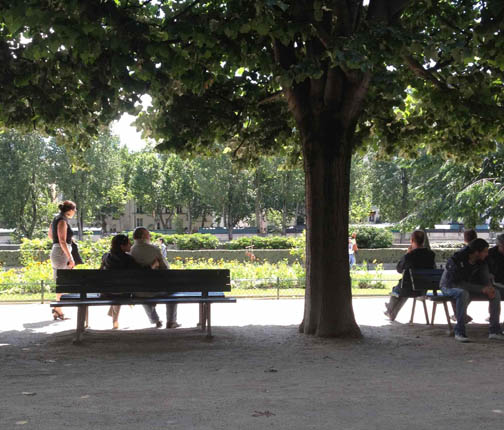 are the 12th-century lovers Abélard and Héloïse, who have this large and lovely gazebo-like grave. Look for cats in the cemetery; some will let you pet them.
are the 12th-century lovers Abélard and Héloïse, who have this large and lovely gazebo-like grave. Look for cats in the cemetery; some will let you pet them.
You'll certainly be going to Notre Dame the minute it's reopened, so if, after spending some calm and reflective time inside that stunning cathedral, you want to unwind a bit outside—especially if the weather is nice—just head around to the back of the structure. There you'll find the lovely Square John XXIII. This place is beautiful year-round, but it's especially nice when the weather is nice and the trees and the flowers are fresh and in bloom. People will be strolling around, sitting on the benches reading, and just generally relaxing. You'll hear low-toned conversations, music, and the sounds of quiet life. Go here: I'm pretty sure you'll really like it.
|
Like any other city, Paris has its share of scammers and other creatures eager to part you and your money. A recent scam involves someone stopping you on the street to tell you that they found a gold ring that you may or may not have dropped. They'll try to get you to give them money for it, and if this starts to remind you of those emails from faraway places asking for your bank account number so that untold millions can be deposited there, well, it should. Ignore the gold ring and the person who found it. |
Walking around the berges (banks) of the Seine, in nearly any part of the city, can be really fun, relaxing, surprising, and even invigorating. You'll find a different culture on the banks in the various neighborhoods through which the river passes, and that means you need to check out the banks—on both sides of the 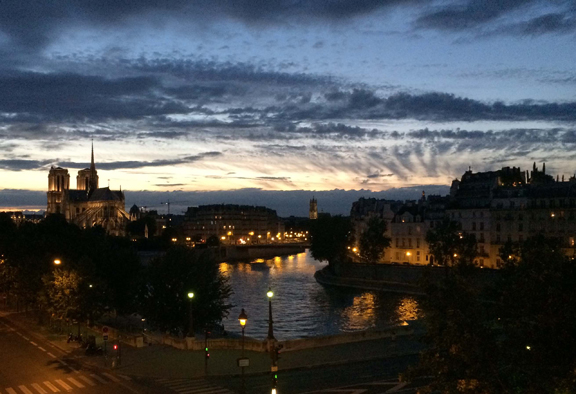 river—throughout the city. Tom thinks you'll likely find that the left bank offers the more interesting alternatives, but he'll leave that to you. Lots and lots of young people gather around sunset on the banks near Notre Dame and the Ile Saint-Louis, and that also means the banks that form the "point" of the Ile Saint-Louis, which in Tom's view are quite beautiful. Depending on the time of day, there will be people having picnics, drinking, playing music, singing, and, in some parts of the city, dancing. For example, there's a group that gathers on the left bank between the Pont Sully and the Pont d'Austerlitz to tango, and some of these people are really good. Sometimes things will get rowdy on the banks, and you won't be surprised to learn that the rowdy quotient moves in direct proportion to the drinking quotient. Things rarely get out of hand, though, and it's pretty rare to see an act of aggression. You should also check out the Pont des Arts, which connects the left bank to the Louvre. This bridge is especially busy and interesting during the weekends when the weather is nice. Since it's a pedestrian bridge, people throw down blankets and have simple—and even complicated feasts. Do have a look.
river—throughout the city. Tom thinks you'll likely find that the left bank offers the more interesting alternatives, but he'll leave that to you. Lots and lots of young people gather around sunset on the banks near Notre Dame and the Ile Saint-Louis, and that also means the banks that form the "point" of the Ile Saint-Louis, which in Tom's view are quite beautiful. Depending on the time of day, there will be people having picnics, drinking, playing music, singing, and, in some parts of the city, dancing. For example, there's a group that gathers on the left bank between the Pont Sully and the Pont d'Austerlitz to tango, and some of these people are really good. Sometimes things will get rowdy on the banks, and you won't be surprised to learn that the rowdy quotient moves in direct proportion to the drinking quotient. Things rarely get out of hand, though, and it's pretty rare to see an act of aggression. You should also check out the Pont des Arts, which connects the left bank to the Louvre. This bridge is especially busy and interesting during the weekends when the weather is nice. Since it's a pedestrian bridge, people throw down blankets and have simple—and even complicated feasts. Do have a look.
Finally, you'll be walking around a lot and likely will get hungry. The map below shows some of Tom's favorite places for outdoor casual dining—these are parks or other public places where it's OK to bring in a sandwich or a salad, unwrap and unwind and nosh on something tasty. One thing to note, though: if you see a sign that says "pelouse interdite" (which translates, roughly, to "forbidden lawn"), do not plunk yourself down there. The police are quite likely to come and ask you to move. They take this seriously. Just sit on a bench or one of the lovely iron chairs.
Readers Chime In...
Michelle from Sydney suggests the gardens of the Palais Royal. "We used to go here at dusk with cheese, champagne, paté and biscuits for a meal sitting in the gated gardens on the delightful seats. We shared our little garden space with a Parisian family one evening. The parents took our photo for us; they were having champagne and salad for dinner, too. We stayed there till dark then walked around the adjoining arcades...Sarah Turnabal mentions it in her book Almost french."
Ellen writes very enthusiastically about the Jardins et Musée Albert Kahn (14 rue du Port, 92100 Boulogne Billancourt 01-46-04-52-80 [Métro : Boulogne Pont de Saint-Cloud]): Just outside of Paris and easily accessible by metro and bus, the gardens (there are 5 in total) and the museum were the creation of Albert Kahn, a rich industrialist who made a fortune in diamonds in the early part of the 20th century. Kahn was interested in photography, so he personally paid to send photographers throughout the world to visually document life as it existed at that time. The Archives de la Planète, as this image collection is called, is housed in the Musée, and there are sometimes special exhibits highlighting a particular topic. The gardens are beautiful - particularly the Japanese garden. I know this is a little bit off the beaten track, but it is just a wonderful place to visit on a beautiful day.
Steven from Long Island has this to say about the rue St Denis: "Whatever you do, do not walk down St Denis at night with a video camera. In fact do not go down that street in the daytime with a camera. Nor should you ride a bicycle down that street, especially the wrong way! You will be asking for trouble. I unknowingly went down that street and did all of the above on a Sunday when everything was locked up. The police were going to lock me up! What did I do you ask? The first chance I got I hopped on my bike and pedaled as fast as I could to the furthest arrondissement that I could find!" Tom pretty much agrees with Steven.
Robert has some tips for walking around in Paris: "I have found that carrying a string shopping bag, even if empty, keeps away the people like the ones who find gold rings on the sidewalk, or are trying to get me to contribute to the Bosnia relief fund. Also, my wife and I try to walk like older French couples by walking arm and arm, or when alone with your hands clasped behind your back."
Bob tells an interesting story about Paris's interesting mechanical public bathrooms. This isn't dangeorus, despite how it might sound, and those in the know will realize precisely what happened: "We were walking through a park and my wife had an urge to use one of the newer public bathrooms. As we waited a person came out and told my wife to enter. She did, the door closed and soon after she let out a scream. On leaving she was somewhat wet. I am sure you know why. This actually happened and I can't help but wonder if others have had the same experience. I hope not." Don't let this dissuade you from using one of these marvelous devices.
M. chides Tom: "As for 'neat places to walk around,' how did you manage to omit the Canal St Martin? During anything but cold or wet conditions, from about 5pm to sundown, the part close to Jardin Villemin will be swarmed with pic-nicers (mostly but not entirely young) and the whole of the canal is flanked by hip shops, restaurants, cafes, and bars." M. and all of you should know that Tom considers the Canal St Martin a place to hang out, and not so much a place to walk around. So you'll find it on the "Hanging Out" page. (But in truth I only added this after M's comment.)
